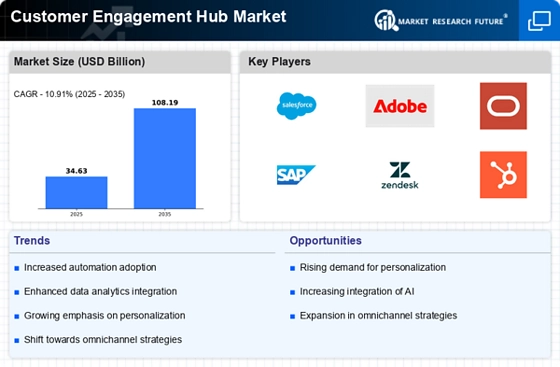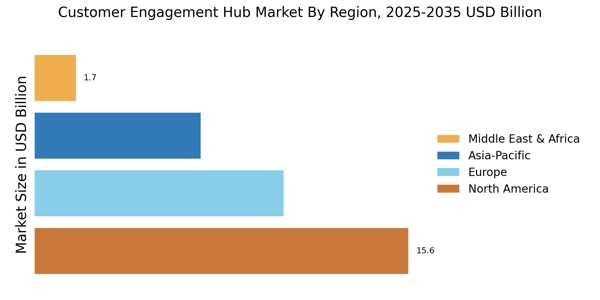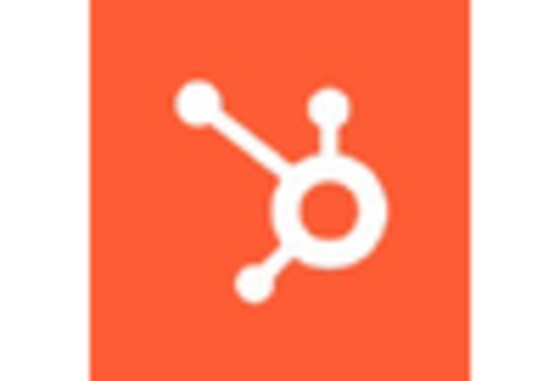Growing Importance of Data Analytics
The growing importance of data analytics is a key driver in the Customer Engagement Hub Market. Organizations are increasingly leveraging data to gain insights into customer behavior, preferences, and trends. This analytical approach enables businesses to tailor their engagement strategies effectively, resulting in improved customer satisfaction and loyalty. Recent studies suggest that companies utilizing data analytics in their customer engagement efforts can achieve a 15-20% increase in customer retention. As data becomes more accessible and sophisticated analytical tools emerge, the Customer Engagement Hub Market is poised for growth. Businesses that harness the power of data analytics are likely to gain a competitive edge, as they can make informed decisions that enhance customer interactions and drive revenue.
Shift Towards Omnichannel Engagement
The shift towards omnichannel engagement is reshaping the Customer Engagement Hub Market. Customers now expect a seamless experience across multiple channels, including online, mobile, and in-store interactions. This trend compels businesses to adopt integrated engagement strategies that provide consistent messaging and support. Data shows that organizations implementing omnichannel strategies can see a 30% increase in customer satisfaction. As companies strive to meet these expectations, the Customer Engagement Hub Market is evolving to offer solutions that facilitate cohesive customer journeys. This shift not only enhances customer experiences but also drives operational efficiencies, as businesses can streamline their engagement processes across various platforms.
Rising Demand for Enhanced Customer Experiences
The Customer Engagement Hub Market is witnessing a notable increase in demand for enhanced customer experiences. Organizations are increasingly recognizing the importance of delivering personalized interactions to foster customer loyalty and satisfaction. According to recent data, companies that prioritize customer experience are likely to see a 10-15% increase in revenue. This trend is driven by consumers' expectations for tailored services and immediate responses, compelling businesses to invest in sophisticated engagement solutions. As a result, the Customer Engagement Hub Market is evolving to meet these expectations, integrating advanced analytics and feedback mechanisms to refine customer interactions. This shift not only enhances customer satisfaction but also drives long-term business growth, as organizations that excel in customer engagement tend to outperform their competitors.
Increased Focus on Customer Retention Strategies
An increased focus on customer retention strategies is emerging as a critical driver in the Customer Engagement Hub Market. Businesses are recognizing that retaining existing customers is often more cost-effective than acquiring new ones. This realization is prompting organizations to invest in engagement solutions that foster loyalty and long-term relationships. Data indicates that improving customer retention rates by just 5% can lead to a 25-95% increase in profits. Consequently, the Customer Engagement Hub Market is adapting to support these retention efforts, offering tools that enhance customer interactions and provide valuable insights into customer needs. As companies prioritize retention, the demand for effective engagement solutions is likely to grow, further propelling the market forward.
Technological Advancements in Communication Tools
Technological advancements are significantly shaping the Customer Engagement Hub Market. The proliferation of communication tools, such as chatbots, social media platforms, and mobile applications, has transformed how businesses interact with customers. These technologies enable real-time communication and facilitate seamless engagement across various channels. Data indicates that companies utilizing advanced communication tools can improve customer retention rates by up to 20%. As organizations adopt these technologies, the Customer Engagement Hub Market is likely to expand, driven by the need for efficient and effective customer interactions. Furthermore, the integration of artificial intelligence and machine learning into these tools enhances their capabilities, allowing for more personalized and responsive customer service.


















Leave a Comment